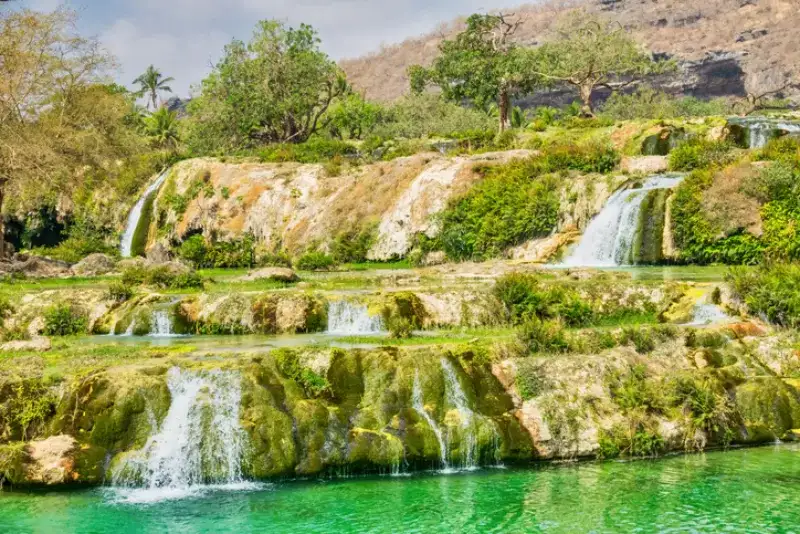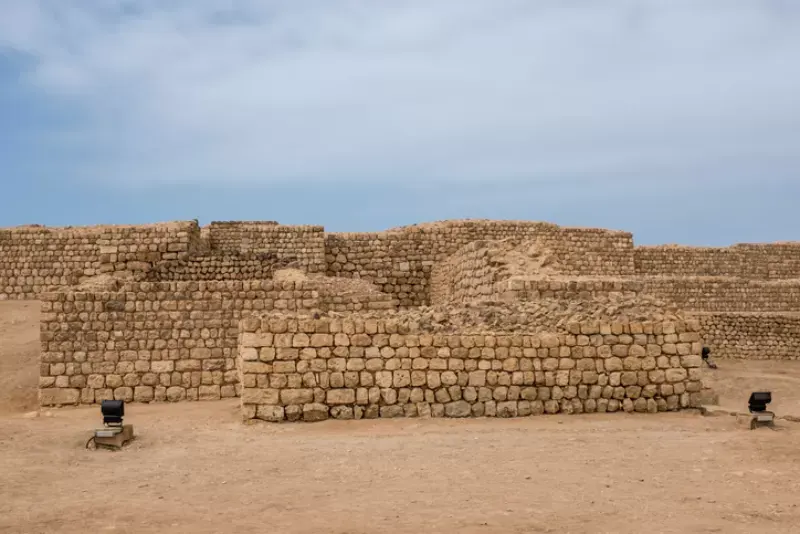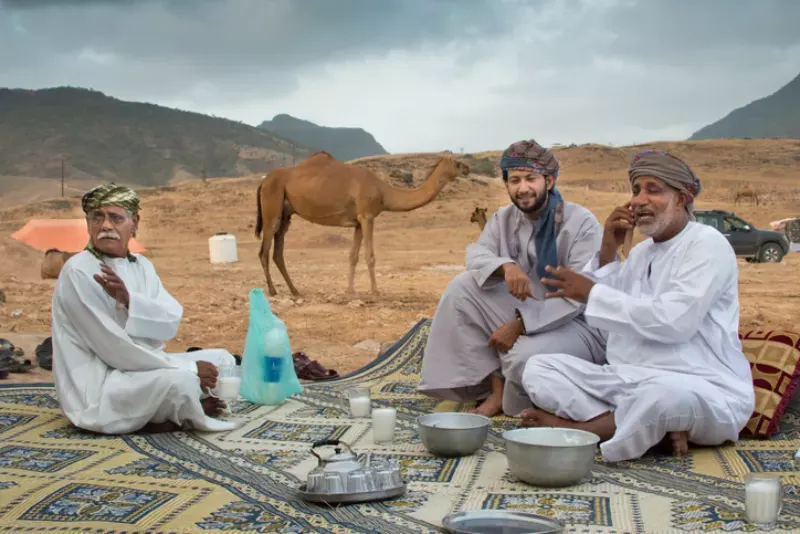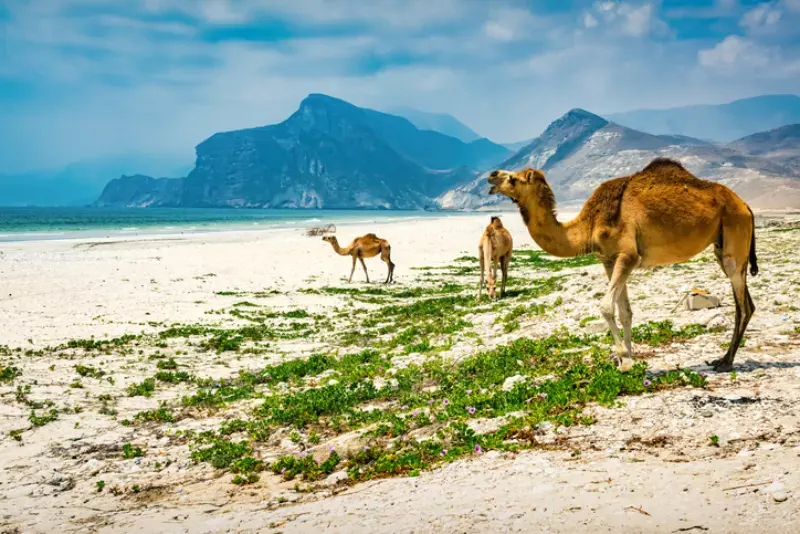Dhofar
Discover Dhofar, Oman, a unique region transformed by the annual Khareef monsoon into a lush paradise. Explore Salalah, its capital, and delve into its rich history as a frankincense hub, encounter diverse wildlife like the Arabian leopard, and immerse yourself in distinct tribal cultures. This guide highlights top attractions, historical sites, and outdoor adventures in this extraordinary Arabian gem.

Dhofar stretches across 99,300 square kilometers of Omani terrain, claiming the title of largest governorate among the country's eleven administrative divisions. Home to over 408,000 residents, this southern region stands apart from its Arabian Peninsula neighbors through a remarkable climatic anomaly. Each year, a seasonal monsoon—locally known as Khareef—blankets the landscape for approximately three months, conjuring verdant scenes rarely witnessed elsewhere in Arabia.
Salalah, the capital city of Dhofar, presents visitors with a tapestry of historical significance and natural splendor. The city serves as a gateway to lush monsoon-touched panoramas and archaeological treasures that whisper tales of bygone eras. Towering between 3,000 and 4,000 feet, the Dhofar Mountains command the horizon while harboring extraordinary ecological wealth. These elevated sanctuaries shelter the elusive Arabian leopard alongside more than 750 plant species—a botanical collection representing over three-quarters of Oman's entire floral diversity.
The pages ahead will guide you through this fascinating corner of Arabia, illuminating the seasonal wonders of Salalah during the Khareef and tracing the region's storied past as a frankincense trading powerhouse. You will encounter the distinctive cultural mosaic of Dhofar, where tribal communities preserve languages markedly different from traditional Arabic. These elements combine to create an Arabian destination unlike any other—a place where ancient traditions, remarkable biodiversity, and seasonal transformation continue to enchant travelers seeking experiences beyond the ordinary.
Experiencing Salalah and the Dhofar Oman Region
Between June and September, Dhofar undergoes a remarkable metamorphosis into an emerald sanctuary, drawing multitudes seeking escape from the scorching Arabian heat. This seasonal transformation creates a striking juxtaposition against the tawny expanses characteristic of the Peninsula, offering travelers an encounter with an entirely different face of Arabia.
Things to do in Salalah Oman during Khareef
Khareef season drapes Salalah in atmospheric mists while mountain springs awaken, birthing cascades across landscapes seldom associated with this corner of the world. The mercury drops considerably during these months, rendering outdoor exploration particularly delightful. Visitors might partake in:
- Boat excursions through verdant valleys once parched by the desert sun
- Traditional performances illuminating the cultural heritage of Omani tribal communities
- Seasonal culinary celebrations honoring the monsoon's bounty
The optimal window for witnessing this spectacle spans from late June through early September when the terrain achieves peak verdancy. During this period, Omani nationals and residents from neighboring Gulf states flock to Salalah specifically for this natural phenomenon, infusing the region with celebratory energy.
Exploring Wadi Darbat and Mughsail blowholes
Wadi Darbat represents the crown jewel among Dhofar's natural treasures. Situated 40 kilometers east of Salalah, this valley showcases tumbling waterfalls, placid pools, and diverse fauna. The wadi reveals its full splendor during Khareef when cascades reach maximum volume. Visitors may charter small vessels to navigate the valley waters or embark upon hiking trails affording sweeping vistas of the surroundings.
On Salalah's western flank lies Mughsail Beach, positioned approximately 40 kilometers from the urban center. This immaculate expanse of alabaster sand gains fame through its dramatic coastal cliffs and remarkable natural blowholes. These geological formations propel seawater skyward, reaching heights of 30 meters during high tide, creating a spectacle particularly cherished by photography enthusiasts. Adjacent Marneef Cave presents intriguing rock configurations alongside panoramic seaward views.
UNESCO World Heritage: Land of Frankincense
The Land of Frankincense UNESCO designation encompasses four archaeological sites illuminating Dhofar's central role in ancient aromatic commerce. These locations include Shisr (alternatively known as Wubar), Sumhuram, Al Baleed, and Wadi Dawkah.
Al Baleed Archaeological Park, positioned near Haffa Souq, presents extensive remnants of a once-thriving settlement, including fortress structures and an imposing mosque. Sumhuram at Khor Rori functioned as a bustling port facilitating frankincense exportation, featuring substantial stone architecture overlooking a freshwater inlet.
Frankincense continues as a fundamental element of Omani cultural identity. The fragrant resin, harvested from Boswellia tree bark, flourishes throughout Wadi Dawkah, where visitors witness traditional collection methods firsthand. Dhofar produces globally unrivaled frankincense quality, readily available at local marketplaces such as Hafa Souq in Salalah.

The Story of Dhofar Through Time
Dhofar cradles tales stretching across millennia, with archaeological discoveries revealing human presence dating back more than seven thousand years. The sands of this ancient land bear witness to civilizations that flourished and faded, each leaving behind cultural imprints that form a rich historical mosaic.
From ancient incense to modern trade
Frankincense forms the golden thread woven throughout Dhofar's historical narrative. This aromatic treasure established the region as the world's premier source, spurring the creation of elaborate trade networks that connected Arabian shores to distant lands—Mesopotamia, Egypt, and the Indian subcontinent. Along these storied routes flowed not merely frankincense but a diverse bounty of valuable commodities: exotic spices, glittering gemstones, and finely crafted textiles.
The celebrated explorer Marco Polo, upon visiting in the 13th century, recorded his impressions of the region, noting that "Dufar is a great and noble and fine city" where "much white incense is produced". Frankincense harvested from Dhofar's groves accumulated in fortified settlements before embarking on journeys to far-flung markets, generating substantial wealth for those who controlled this precious commodity.
The rise and fall of Sumhuram and Ubar
Sumhuram emerged in the 3rd century BCE as a vital outpost serving the Kingdom of Ḥaḍramawt. This fortified harbor at Khor Rori facilitated maritime commerce with Indian and Mediterranean merchants until the 5th century, when its abandonment coincided with the likely formation of a sandbar that rendered the estuary impassable.
The legendary Ubar—often referenced as the "Atlantis of the Sands"—flourished as a prosperous desert oasis commanding key frankincense caravan routes. After centuries of prominence, this fabled city met a dramatic fate when the limestone caverns supporting its foundations suddenly collapsed. Modern technology finally confirmed its existence in 1992, when satellite imagery guided scientists to ruins buried beneath the Empty Quarter desert, solving a mystery that had persisted for centuries.
Dhofar's role in Oman's national history
By the 12th century CE, Dhofar fell under the governance of Aḥmad ibn-Muḥammad al-Manjawa as an Omani tributary. The subsequent centuries saw the region oscillate between periods of relative autonomy and conflict. Notable among these episodes was the 1895 rebellion, during which the al Kathir tribesmen seized control of the Sultan's fortress in Salalah. More recently, Dhofar became the focal point of a decade-long insurrection from 1965-1975, opposing Sultan Saʿīd ibn Taymūr's restrictive governance. This turbulent chapter ultimately closed through a combination of military campaigns and progressive development programs.

People, Tribes, and Languages of Dhofar
Dhofar's population stands apart from the rest of Oman through a remarkable patchwork of tribal communities, each maintaining distinctive languages and cultural traditions. This southern region preserves indigenous practices that share more commonalities with neighboring Yemen than with the cultural expressions found in northern Oman.
The Qara, Mahra, and Bait Kathir tribes
Several major tribal groups have called the mountains and deserts of Dhofar home for centuries. The Qara tribe, namesakes of the Qara Mountain Range, predominantly occupies the elevated territories. Neighboring them, the Mahra tribe maintains powerful historical connections to Yemen and carved a significant place in early Islamic military campaigns, particularly across North Africa. Their renowned martial skill centered around exceptional cavalry units mounted on the Mehri camel breed—animals celebrated for their remarkable speed and agility.
The desert-dwelling Bait Kathir (Al Kathiri) represents another influential tribal confederation encompassing several lineages, including Al-Shanfari, Al-Rawas, Al-Marhoon, and Bait Fadhil. Their political significance echoes through historical records, notably in their 1895 uprising when they seized control of the Sultan's fortification in Salalah.
Shehri and Mehri: Living linguistic heritage
The linguistic landscape of Dhofar's tribal societies reveals perhaps their most extraordinary cultural dimension. Mountain communities primarily communicate in Shehri (alternatively called Jibbali, translating to "mountainous"), a Modern South Arabian language entirely separate from Arabic. UNESCO classifies this ancestral tongue as "severely endangered," with merely 59,000 speakers documented between 2001-2011.
Equally noteworthy is Mehri, spoken by approximately 115,200 people scattered across Oman, Yemen, and various Gulf states. These languages share no mutual intelligibility with Arabic, instead functioning as living connections to ancient South Semitic linguistic traditions that flourished in the region long before Arabic's arrival.
Cultural practices and beliefs in the mountains
The mountain tribes historically maintained ritual practices distinct from mainstream Islamic observances. Gordon Noel Jackson documented in 1943 that these communities exhibited highly superstitious tendencies and engaged in pre-Islamic ceremonial traditions. Their spiritual worldview often centered around natural elements, bestowing special significance upon environmental features.
Among their most celebrated cultural expressions stands Al-Bar'ah, a distinctive Bedouin musical performance from the Dhofar highlands that has earned UNESCO recognition. This martial dance, executed to rhythmic drumming and poetic recitations in tribal dialects, embodies the chivalrous spirit, strength, and hospitality central to Bedouin cultural identity. Each tribal group preserves its characteristic variation of al-Bar'ah, featuring unique drumming patterns and movement sequences that reinforce their distinct cultural signatures.

Customize Your Dream Vacation!
Get in touch with our local experts for an unforgettable journey.
Plan Your TripNature, Wildlife, and Outdoor Adventures
Dhofar unfolds as a natural sanctuary where misty mountains give way to untouched coastlines, presenting extraordinary ecological diversity. This geographical mosaic creates perfect conditions for memorable outdoor pursuits and remarkable wildlife encounters, unlike anywhere else on the Arabian Peninsula.
Dhofar Mountains: Hiking and wildlife spotting
Monsoon-sculpted landscapes define the Dhofar Mountains, offering hikers passage through ever-changing terrains. Eastern reaches cradle Wadi Darbat with its shimmering emerald pools and tumbling waterfalls—vital watering points for countless wildlife species. Post-Khareef, the slopes surrounding Salalah burst into lush verdancy, beckoning explorers to their transformed state.
Adventurous trekkers navigate paths ascending to 800 meters, unveiling secluded valleys where frankincense trees stand as living monuments to ancient trade. The botanical tapestry shifts noticeably with elevation gain—larger tree species appear unexpectedly, while distinctive dragon trees mark the approach to mountain passes. Sharp-eyed hikers frequently glimpse rock hyraxes scampering across rocky outcrops, adding wildlife drama to mountain excursions.
Arabian leopards and endemic flora
Hidden within Dhofar's remote recesses prowls the Arabian leopard—a critically endangered icon of wild Arabia. The reserve near Salalah harbors approximately one-tenth of the world's remaining 250 Arabian leopards, with global numbers dwindling to a mere 100-120 individuals. Recent scientific findings have expanded these elusive felines' known territory 40 kilometers northward into the Nejd plateau, kindling fresh optimism for their survival.
Fog-draped escarpments nurture Oman's richest concentration of endemic plant species. Scientists have documented roughly 900 vascular plants within this mist oasis, including 60 found nowhere else on Earth. Among these botanical treasures stand two genera exclusive to the region—Cibirhiza and Dhofaria. The economically precious frankincense tree (Boswellia sacra) and the imposing Terminalia dhofarica—reaching heights of twelve meters—exemplify this remarkable floral heritage.
Diving, birdwatching, and eco-tourism
Beneath Dhofar's coastal waters lies an underwater realm of extraordinary diversity. The Hallaniyat Islands beckon divers with pristine coral gardens, labyrinthine underwater caves, and pelagic visitors including graceful manta rays and massive whale sharks. During Khareef, a truly exceptional phenomenon occurs—giant kelp forests materialize in waters near Salalah, creating one of Earth's rare locations where divers may explore both vibrant coral ecosystems and kelp sanctuaries within the same diving grounds.
Birdwatchers discover paradise along Dhofar's coastal lagoons, locally known as khawrs. These vital wetlands serve as essential rest havens for migratory species traversing continents. Prime observation points include Khor Rouri, Khawr al Mughsayl, and the freshwater springs of Ain Razat and Ain Hamran. Patient observers might record rarities such as Pheasant-tailed Jacana, Cotton Pygmy-Goose, Arabian Partridge, and Arabian Warbler. Recognizing this ecological treasure, Oman's Environment Authority now courts investment in sustainable eco-tourism at Khor al Mughsail Nature Reserve—acknowledging both conservation imperatives and development potential.

Conclusion
Dhofar emerges as an extraordinary testament to both natural splendor and human ingenuity within the Arabian Peninsula. This southern Omani territory presents landscapes that confound expectations—monsoon-kissed mountains draped in mist during Khareef season, unblemished coastal stretches hugging the shoreline, and ancient groves of frankincense trees whose precious resin once powered global commercial networks.
Few places in Arabia offer comparable experiences. Travelers discover UNESCO World Heritage monuments preserving the legacy of ancient incense trade alongside opportunities to glimpse the critically endangered Arabian leopard in its natural habitat. Dhofar rewards the curious explorer with authentic discoveries seemingly awaiting around every mountain pass and coastal inlet.
The cultural richness of Dhofar further distinguishes it from neighboring Omani regions. Indigenous tribal communities maintain their unique identities through rapidly vanishing languages such as Shehri and Mehri. Traditional expressions like Al-Bar'ah performances constitute living cultural artifacts predating modern political boundaries, their rhythms and movements carrying echoes of ancient times.
Visitors witnessing the verdant transformation during Khareef season or exploring underwater realms off the Dhofari coast encounter an Arabia that challenges conventional perceptions. The striking juxtaposition of mist-shrouded mountains against nearby desert expanses creates a geographical marvel demanding personal observation to fully comprehend its magnificence.
Dhofar stands as a singular confluence where natural wonders, historical significance, and vibrant traditions intersect. Those who journey through this remarkable territory invariably depart with enhanced appreciation for Oman's multifaceted heritage and the extraordinary ways human societies have flourished at this cultural crossroads across millennia.
FAQs
Q1. What is the best time to visit Dhofar?
The best time to visit Dhofar is during the Khareef season, from late June to early September. This is when the region experiences a unique monsoon, transforming the landscape into a lush green paradise with cooler temperatures and flowing waterfalls.
Q2. What are some must-visit attractions in Dhofar?
Some must-visit attractions in Dhofar include Wadi Darbat for its waterfalls and wildlife, Mughsail Beach for its dramatic blowholes, and the UNESCO World Heritage sites of the Land of Frankincense, such as Al Baleed Archeological Park and Sumhuram.
Q3. What makes Dhofar's culture unique?
Dhofar's culture is unique due to its distinct tribal communities, such as the Qara and Mahra, who speak endangered languages like Shehri and Mehri. The region also preserves traditional practices like the Al-Bar'ah dance, recognized by UNESCO as intangible cultural heritage.
Q4. What wildlife can be seen in Dhofar?
Dhofar is home to diverse wildlife, including the critically endangered Arabian leopard, rock hyraxes, and various bird species. The region's waters also offer opportunities to see marine life such as manta rays and whale sharks during diving expeditions.
Q5. How has frankincense shaped Dhofar's history?
Frankincense has been integral to Dhofar's history, making it a crucial hub in ancient trade networks. The region was known for producing the finest quality frankincense, which led to the establishment of prosperous cities like Sumhuram and Ubar, and continues to be an important part of local culture and economy today.











